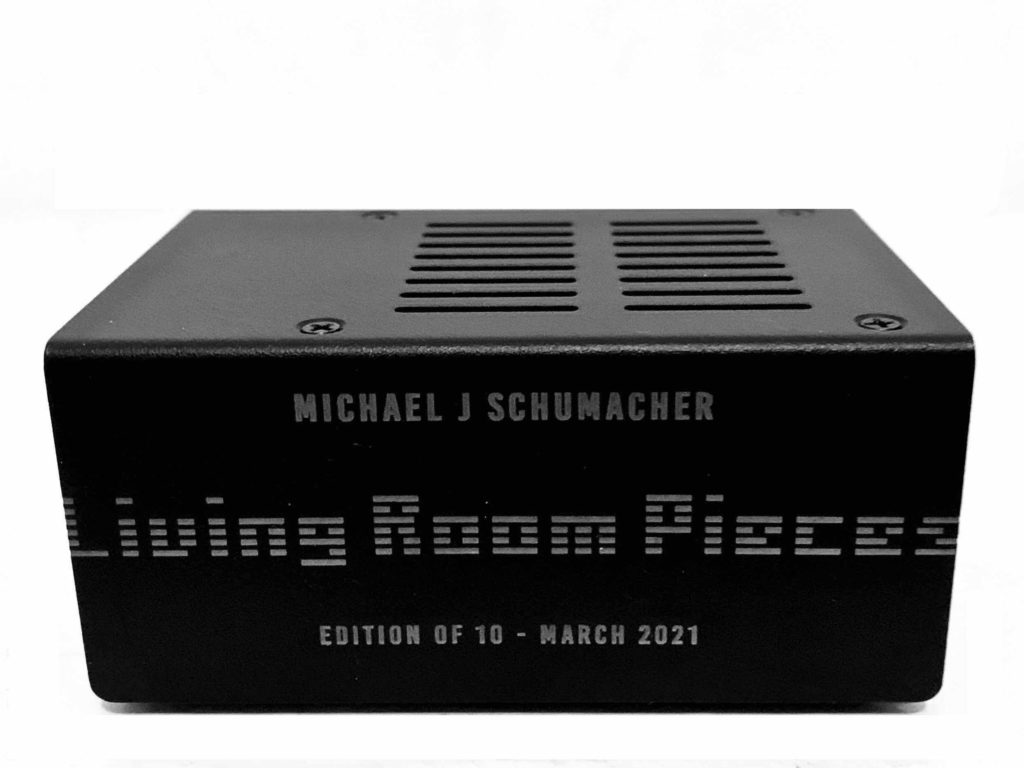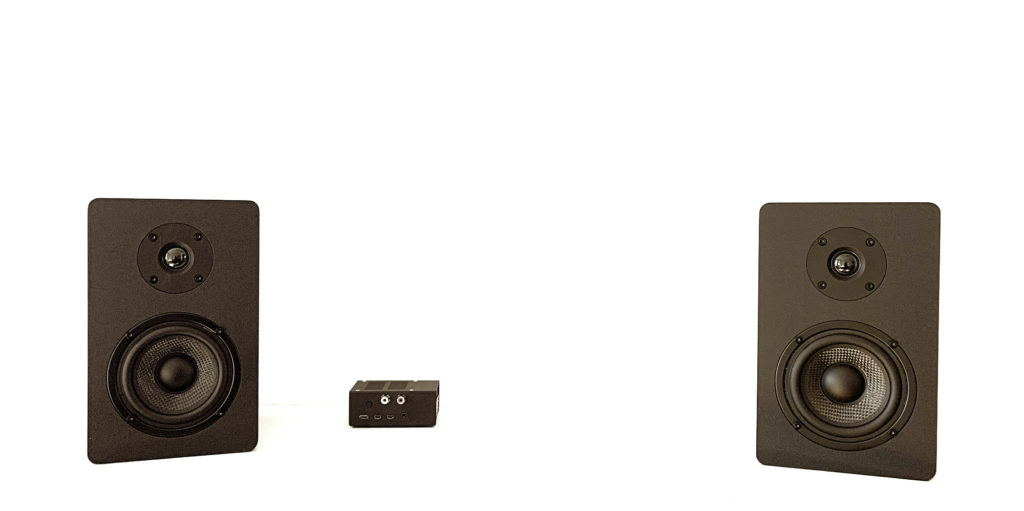Living Room Pieces is a sound installation that explores listening in the home, reinventing the living space as a place of engagement and discovery. You set it up and start it and occasionally, unexpectedly, it makes sounds, always in different ways. Its huge inventory of sounds and the unpredictability of their occurrence create a listening environment that transforms one’s relationship to physical, architectural, social and aural space.
“LRP” is a piece by Michael Schumacher – Installation is available on loan for up to two months.

Living Room Pieces is a sound installation that explores listening in the home, reinventing the living space as a place of engagement and discovery. You set it up and start it and occasionally, unexpectedly, it makes sounds, always in different ways. Its huge inventory of sounds and the unpredictability of their occurrence create a listening environment that transforms one’s relationship to physical, architectural, social and aural space.
The piece’s first manifestation was in 2005, using a 12 channel sound system installed in an apartment at the Chelsea Hotel, where it ran uninterruptedly for one year. This new version runs on an inexpensive Raspberry Pi computer and reduces the number of speakers to two – a bit like “stereo” but configured differently, to create an immersive environment. The March 2021 edition of 10 features a case designed by artist Zorica Čolić.
This edition is available to interested people as a two month loan. The experience of Living Room Pieces is unique and can only be fully appreciated over long time periods. The composer and Harvestworks are working together to bring this experience to as many people as possible, given the unusual nature of the work. The procedure is as follows:
1. If you are interested in borrowing the equipment and software to run the piece, contact the composer or Harvestworks.
2. The equipment consists of
- Raspberry Pi computer in custom case w/power supply
- SD card (installed in computer – non-removable)
- 1 pair Mackie CR-5 Speakers
- 30’ speaker cable
- stereo RCA connection cable
The speakers measure approximately 6” x 6” x 8” and the computer 4” x 1.5” x 2”. It is recommended that the speakers be placed at least 15’ apart. Two free AC outlets (or 1 with a split connection) are required. The piece is designed to stay on for the entire duration of the loan. It may be silenced by turning off the speakers, but it is requested that the computer remain on.
3. Arrangements will be made to deliver the equipment to you, with detailed instructions on setting up the installation.
4. Technical help by email or phone is available.
5. The length of the loan is agreed on, not to exceed two months. You have the option to return the piece before the agreed upon end date of the loan.
6. Shipping is free for Harvestworks members. Harvestworks provides you with a prepaid return shipping label. You may also pick up and return the equipment to Harvestworks in person.
7. There is no charge to borrow the installation and the associated equipment.
8. You agree to leave a credit card number with Harvestworks as a security deposit insuring timely return of the equipment.

Description of the piece’s functioning: When the computer is turned on, it automatically launches the program that generates the piece. A brief test sound is heard, confirming that both speakers are working. The program then sets up a seven day cycle, each with a unique timing algorithm that determines the number and type of sounds heard on a given day. This cycle will continue for as long as the computer is left on. Though the structure of a given day repeats, the specific sounds played do not, meaning that there will be constant variation within the structural framework set up by the program. There are over 300 modules, each a unique sound along with the processes used to vary it, represented by over 7000 sound files stored in the computer’s memory.
The innovation of Living Room Pieces is twofold: its “delivery system” and its concept of musical structure as it relates to the flow of time of everyday life. It moves the setting of the listener’s experience from the concert hall (or record player) to the living space itself, as the site where the fundamental contemporary paradox of control and the lack thereof plays itself out. Within this space, time is largely unfixed and unstructured, and within this temporal fluidity the listener encounters unexpected sonic engagements that may excite, humor, inspire meditation or introspection, fix a moment in time, or simply blend unnoticeably into the ambient environment.

Based in Brooklyn, Michael J. Schumacher has worked with spatialized sound, computers and electronics since the 1980s, creating multi-channel, generative “Room Pieces” presented in galleries, museums, concert halls, public and private spaces. XI records has published a DVD set of five sound installations as computer applications, playable on up to eight speakers, which may be installed on a computer to create sound environments in the home. Schumacher’s composition “Grid”, a computer- generated score, has been in exhibitions in New York, Barcelona and Houston. His building-wide installation at EMPAC, in Troy New York, ran 24/7 for one year.
His interest in the relationship of musical form and architecture led to the founding of Diapason Sound Art, a gallery devoted to the presentation of multi-channel sound installations, long-duration performances and intermedia artworks. The gallery’s two high quality sound systems and its attention to the details of heightening aural perception made it an optimal space for creating and experiencing minimalist and process-based work. In its 15 years of existence, made possible by the generosity of Mr. and Mrs. Kirk Radke, Diapason presented over 300 artists, at a time when sound art was emerging as a distinct practice in the United States.
Schumacher is the music director of the Liz Gerring Dance Company, with whom he has collaborated on a dozen full-evening length works over the past 20 years, including three large scale pieces produced by the Kasser Theater in Montclair. He also performs regularly with choregrapher Sally Silvers. He studied music composition with Stanley Applebaum, Bernhard Heiden, John Eaton and Vincent Persichetti and piano with Seymour Bernstein, John Ogdon and Shigeo Neriki, and has degrees from Indiana University and Juilliard. He also worked with La Monte Young, Giampaolo Bracali and Milton Babbit. He has collaborated with choreographers, poets, architects, musicians and filmmakers including Oren Ambarchi, Bruce Andrews, Charles Curtis, Ken Jacobs, Victoria Meyers, Donald Miller, Ursula Scherrer and Stephen Vitiello.
He has received awards and residencies from NYFA, Harvestworks, Rennsellaer , DAAD and others. He’s an adjunct professor at NYU and has guest-lectured at Bard and RPI as well as having recently been the Varèse professor at Berlin’s TU.
(2022)





